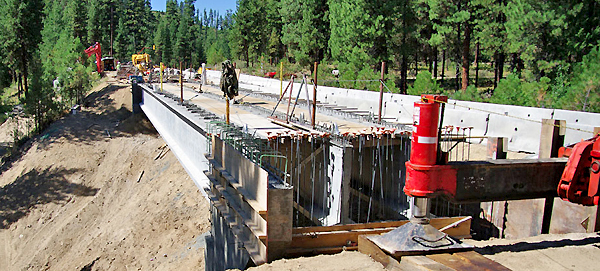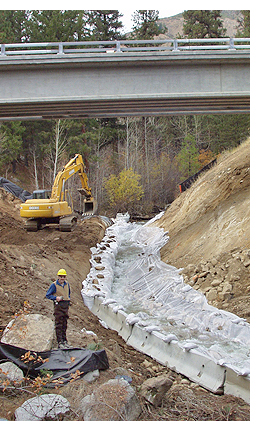

ITD nears completion of fish-friendly project in D-3
The problem:
A culvert 11 miles east of Lowman on Idaho 21 in Boise County was identified by the U.S. Forest Service as a physical barrier that inhibited access by fish and other aquatic species to Five Mile Creek on the upstream side of the culvert.
 The solution:
The solution:
Replace the 300-foot, 72-inch culvert with a 125-foot wide pre-stressed concrete girder bridge, opening up the entire Five Mile Creek watershed for use.
So in mid-June a $1.2 million Forest Service-funded project began with ITD oversight and construction. The impeding culvert at that location has been removed and replaced with a short-span bridge that also has the side benefit of providing wildlife in the area safe passage under the bridge.
The stream has been rehabilitated and re-routed. All stream work on the project is complete, and crews are backfilling around the new bridge and paving approaches and curb this week. The fish-passage project is scheduled to wrap up by early December. Crews will return in the spring to complete seeding, paving and roadway approaches, and other minor work.
“The culvert had long been a barrier, and now that it's gone there is a wider range of habitat for the aquatic species, which contributes to the overall heath of the environment and the species that use it,” said ITD District 3 Environmental Planner Greg Vitley.
“It particularly benefits bull trout, a threatened and protected species that has lost habitat and the elements that contribute to its health due to past land use, management and natural disasters.”
Vitley said “Fish barriers are one of the contributing elements that have degraded bull trout habitat connectivity, which in turn has eliminated access to critical spawning and rearing habitat, limiting the reproduction of the species. Removing the culvert is a step in the right direction not only for bull trout but for other aquatic species that could inhabit the upstream area as well.“
Scott Rudel, D-3 Environmental Planner/Biologist said the project “re-established the physical and biological connectivity of Five Mile Creek and the South Fork of the Payette River (upstream and downstream) where the road crosses over Five Mile Creek.”
“The bridge completely spans the Five Mile Creek channel and allows unrestricted water flow, thereby permitting the passage of fish, aquatic resources, and the transfer of river-bed material, sediment, and debris through an open-bottomed, free-flowing stream that did not exist before.”
Published 11-23-2011